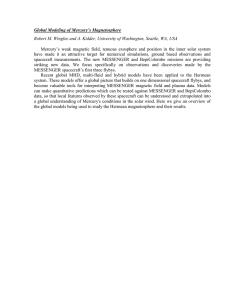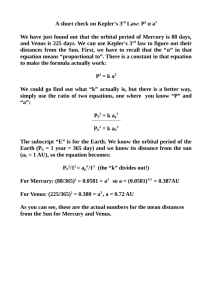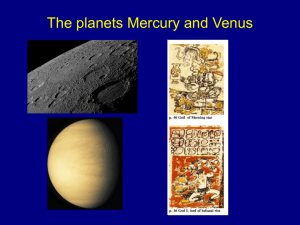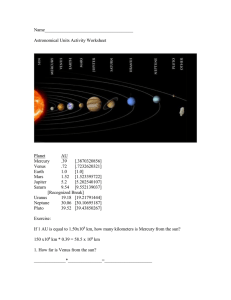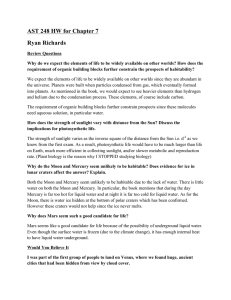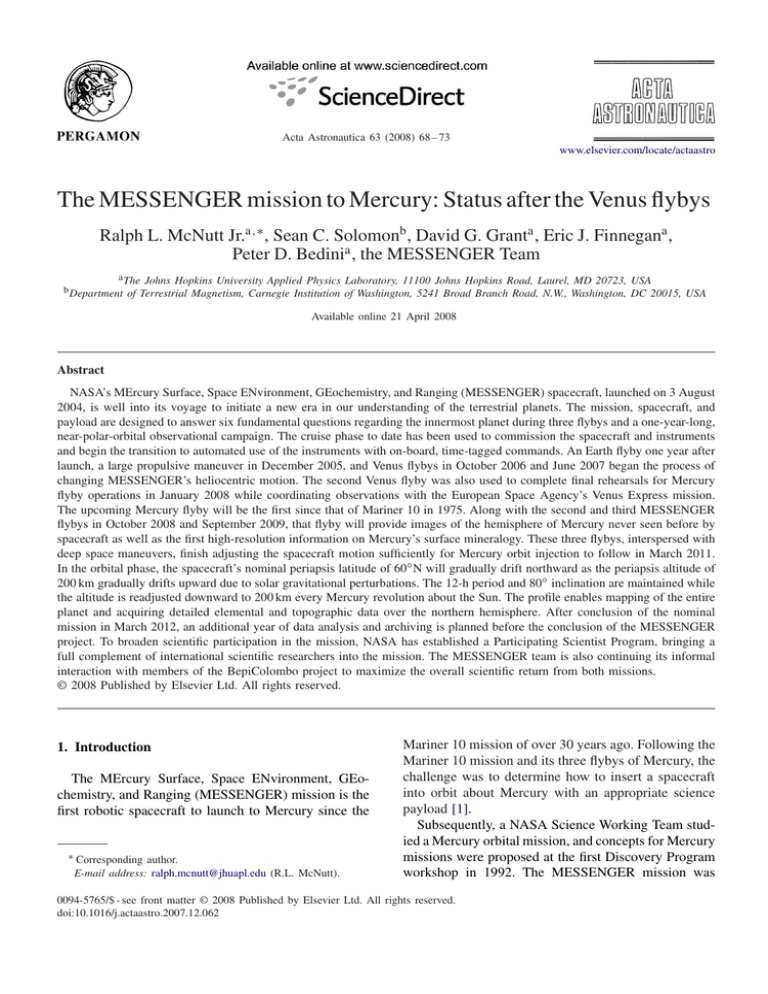
Acta Astronautica 63 (2008) 68 – 73
www.elsevier.com/locate/actaastro
The MESSENGER mission to Mercury: Status after the Venus flybys
Ralph L. McNutt Jr.a,∗ , Sean C. Solomonb , David G. Granta , Eric J. Finnegana ,
Peter D. Bedinia , the MESSENGER Team
a The Johns Hopkins University Applied Physics Laboratory, 11100 Johns Hopkins Road, Laurel, MD 20723, USA
b Department of Terrestrial Magnetism, Carnegie Institution of Washington, 5241 Broad Branch Road, N.W., Washington, DC 20015, USA
Available online 21 April 2008
Abstract
NASA’s MErcury Surface, Space ENvironment, GEochemistry, and Ranging (MESSENGER) spacecraft, launched on 3 August
2004, is well into its voyage to initiate a new era in our understanding of the terrestrial planets. The mission, spacecraft, and
payload are designed to answer six fundamental questions regarding the innermost planet during three flybys and a one-year-long,
near-polar-orbital observational campaign. The cruise phase to date has been used to commission the spacecraft and instruments
and begin the transition to automated use of the instruments with on-board, time-tagged commands. An Earth flyby one year after
launch, a large propulsive maneuver in December 2005, and Venus flybys in October 2006 and June 2007 began the process of
changing MESSENGER’s heliocentric motion. The second Venus flyby was also used to complete final rehearsals for Mercury
flyby operations in January 2008 while coordinating observations with the European Space Agency’s Venus Express mission.
The upcoming Mercury flyby will be the first since that of Mariner 10 in 1975. Along with the second and third MESSENGER
flybys in October 2008 and September 2009, that flyby will provide images of the hemisphere of Mercury never seen before by
spacecraft as well as the first high-resolution information on Mercury’s surface mineralogy. These three flybys, interspersed with
deep space maneuvers, finish adjusting the spacecraft motion sufficiently for Mercury orbit injection to follow in March 2011.
In the orbital phase, the spacecraft’s nominal periapsis latitude of 60◦ N will gradually drift northward as the periapsis altitude of
200 km gradually drifts upward due to solar gravitational perturbations. The 12-h period and 80◦ inclination are maintained while
the altitude is readjusted downward to 200 km every Mercury revolution about the Sun. The profile enables mapping of the entire
planet and acquiring detailed elemental and topographic data over the northern hemisphere. After conclusion of the nominal
mission in March 2012, an additional year of data analysis and archiving is planned before the conclusion of the MESSENGER
project. To broaden scientific participation in the mission, NASA has established a Participating Scientist Program, bringing a
full complement of international scientific researchers into the mission. The MESSENGER team is also continuing its informal
interaction with members of the BepiColombo project to maximize the overall scientific return from both missions.
© 2008 Published by Elsevier Ltd. All rights reserved.
1. Introduction
The MErcury Surface, Space ENvironment, GEochemistry, and Ranging (MESSENGER) mission is the
first robotic spacecraft to launch to Mercury since the
∗ Corresponding author.
E-mail address: ralph.mcnutt@jhuapl.edu (R.L. McNutt).
Mariner 10 mission of over 30 years ago. Following the
Mariner 10 mission and its three flybys of Mercury, the
challenge was to determine how to insert a spacecraft
into orbit about Mercury with an appropriate science
payload [1].
Subsequently, a NASA Science Working Team studied a Mercury orbital mission, and concepts for Mercury
missions were proposed at the first Discovery Program
workshop in 1992. The MESSENGER mission was
0094-5765/$ - see front matter © 2008 Published by Elsevier Ltd. All rights reserved.
doi:10.1016/j.actaastro.2007.12.062
R.L. McNutt et al. / Acta Astronautica 63 (2008) 68 – 73
69
proposed under the Discovery Program in both 1996
and 1998 before being selected for flight [2]. Details of the mission scientific objectives and implementation [3], the payload [4], and mission and
spacecraft design [5] at the time of selection and
beginning of development have been discussed
elsewhere.
2. Ongoing mission
2.1. Launch
MESSENGER, the seventh mission of NASA’s Discovery Program of competed scientific missions, was
launched on 3 August 2004 from Space Launch Complex 17 at the Cape Canaveral Eastern Test Range
(Fig. 1).
Following spacecraft and instrument commissioning,
plans focused on using the Earth flyby to obtain initial
data from some of the spacecraft instruments.
Fig. 2. Image of the Earth from the MDIS WAC taken on approach
to the Earth flyby. Closest approach occurred 2 August 2005, 3:13:08
PM EDT, at 2348 km altitude over Mongolia.
2.2. Return to Earth
Among observations made during MESSENGER’s
Earth flyby on 2 August 2005 were images of Earth
by the Mercury Dual Imaging System (MDIS), including a movie of 358 frames (one color frame per 4 min
for almost 24 h), spectral measurements of the Moon
by the Mercury Atmospheric and Surface Composition
Spectrometer (MASCS) for later calibration of Mercury
measurements, Magnetometer (MAG) measurements of
the Earth’s magnetic field to complete a detailed calibration and alignment check of the instrument, and particle
measurements in the Earth’s radiation belts by the Energetic Particle and Plasma Spectrometer (EPPS), with
focus on measurements of the electrons for final calibration. All calibration results were met with excellent
success.
The images of the Earth (Fig. 2) confirmed the operation of both cameras, including the color capability of
the wide-angle camera (WAC). Images taken even from
distances of tens to thousands of kilometers showed
considerable detail (Fig. 3).
2.3. Cruise to Venus
Fig. 1. MESSENGER launch from Pad 17B of Cape Canaveral Air
Force Station, 3 August 2004, 02:15:56.537 Eastern Daylight Time.
2.3.1. Venus flyby 1
The initial gravity assist at Earth was followed by a
deep-space maneuver (DSM) on 12 December 2005 to
70
R.L. McNutt et al. / Acta Astronautica 63 (2008) 68 – 73
Fig. 3. MDIS WAC image of the Galápagos Islands taken on approach to the Earth flyby at a distance of 56,000 km.
line up the spacecraft for the next gravity assist, this time
at Venus. MESSENGER’s first gravity assist at Venus
occurred at 04:34 EDT on 24 October 2006. The flyby
was at a relatively high altitude (2987 km), included a
long eclipse by Venus, and occurred during a period
of solar conjunction. Given these conditions, it was decided that the best approach was not to plan on payload
use, deferring observations using Venus for calibration
to the second gravity assist there.
A spacecraft safing event occurred just prior to the
Venus flyby and eclipse that has been traced to a singleevent upset (SEU). The spacecraft performed as designed, yielding an excellent—albeit unplanned—test
of the spacecraft safing and autonomy system.
2.3.2. Venus flyby 2
The second Venus gravity assist in June 2007 was
planned as a “full dress rehearsal” for the first flyby
encounter of Mercury by a spacecraft since Mariner 10’s
third and final flyby on 16 March 1975. Initial ground
planning for the spacecraft command loads began 23
February 2007, with a critical design review (CDR) that
included external, independent reviewers on 18 April.
The command loads for the encounter were sent to the
spacecraft on 1 and 4 June prior to the closest approach
on 5 June.
As with the previous planetary encounters, the overriding requirement of this Venus flyby was to shed
spacecraft energy and angular momentum with respect
to the Sun, tightening the spacecraft heliocentric trajectory for eventual orbit insertion at Mercury. The flyby
was successful and extremely accurate; MESSENGER
Fig. 4. Venus seen during departure at 630 nm. The image has been
stretched significantly to bring out the cloud structure.
was on course for the second DSM on 17 October 2007
prior to the first flyby of Mercury in January 2008.
The subsidiary goals for the flyby of Venus included instrument calibrations, practice for operations
during the first Mercury flyby, and doing “science of
opportunity,” including coordinated observations with
the Venus Express mission of the European Space
Agency (ESA) that has been operating in a 24-h elliptical orbit about Venus since 11 April 2006.
All operations went extremely well. The exercise
was extremely helpful in confirming the applicability of
the basic planned operations approach while revealing
how some procedures and processes could be further
optimized. In particular, the coordination of the guidance and control (G&C) operations with required MDIS
gimbal operations for pointing both the WAC and the
narrow-angle camera (NAC) for large-frame imaging
(Fig. 4) and mosaicking (Fig. 5) were validated.
All instruments in the payload were turned on and
operated with the sole exception of the cryocooler for
the Gamma-Ray and Neutron Spectrometer (GRNS).
In addition to requiring tens of hours to cool the germanium crystal to operational temperature, the time
spent close to the planet was too short to accumulate a
statistically significant number of counts. The GammaRay Spectrometer (GRS) active shield was turned on
as practice for Mercury operations and to measure
planetary neutrons. The Neutron Spectrometer (NS)
section was turned on to (1) measure planetary neutrons for the first time with the MESSENGER NS,
R.L. McNutt et al. / Acta Astronautica 63 (2008) 68 – 73
(2) use Venus neutrons for understanding systematic
variations in neutron measurements, and (3) look for
transient signals that could be associated with Venus
lightning. The GRS did not detect any obvious signals
but did see an increase in neutrons and Compton emission associated with Venus while detecting a decrease
in galactic-cosmic-ray-associated signal as the planet
shielded the instrument during closest approach. The
NS also detected neutrons but no transient events.
The X-Ray Spectrometer (XRS) was also powered to look for emission of X-rays from Venus. The
Fig. 5. NAC mosaic of the Venus clouds. On the left the edges of
each frame have been exaggerated to check pointing and alignment;
the mosaic with calibrations applied is on the right.
71
low-energy cutoff of ∼ 1 keV prevented seeing the principal source of atmospheric X-rays from Venus [6], and
no emissions were seen. A general decrease in count
rates was seen as the planet cut off the X-ray sky background near closest approach to Venus (Fig. 6).
Both radio science (RS) and the Mercury Laser Altimeter (MLA) were also in operation, the first to test
procedures and data acquisition that will be important
in refining Mercury’s second harmonic degree and order gravity field, and the second to attempt to probe the
upper layers of Venus’s clouds. The ranging operations
of MLA were carried out during a 13-min interval, and
an analysis of signatures of the received photons is underway.
The Energetic Particle Spectrometer (EPS) section of
the EPPS was turned on but saw no strong signals of
energetic particles or the bow shock. The Fast Imaging
Plasma Spectrometer (FIPS) detected a region of solar
wind flow away from the radial direction from the Sun
prior to the encounter as well as possible signatures
of pick-up ions. More detailed analyses of these data
as well as magnetic field data from the MESSENGER
MAG are ongoing. Comparisons are also being made
with the relevant data sets acquired by Venus Express
instruments in collaborative efforts.
Objectives for both the Ultraviolet and Visible
Spectrometer (UVVS) and the Visible and Infrared
Spectrograph (VIRS) components of MASCS included
completing flat-field and scattered-light observations as
well as providing for scientific observations and testing
Fig. 6. XRS flux during the second Venus flyby. The blue trace shows the decrease of flux associated with the planet. The red trace shows
nominal Sun-pointing solar monitor counts.
72
R.L. McNutt et al. / Acta Astronautica 63 (2008) 68 – 73
observing sequences for the Mercury flybys. VIRS detected atmospheric absorption bands, as expected, on
the dayside of the planet, and UVVS detected Lyman-
and OI 130.4-nm emissions on the dayside as well as
SO2 absorption. On the nightside, the UVVS detected
Herzberg emissions from O2 .
MDIS calibration efforts were focused on final flatfield calibration (Venus is an excellent extended target
in the visible) and scattered-light calibration (especially
for the NAC). The imaging sequences were also planned
to attempt imaging of the surface with the 1000- and
1020-nm filters of the WAC on the nightside of the
planet, similar to results reported from Venus Express.
This successful effort is also contributing to an ongoing
collaborative study by the MESSENGER and Venus
Express science teams.
3. Mercury flybys
The planning for the first Mercury flyby, that occurred on 14 January 2008, began with a preliminary
design review (PDR) for payload operations on 14 May
2007, prior to Venus flyby 2. Planning operations culminated with the upload of the encounter sequence during
the week of 7 January 2008. Interspersed with this effort were the solar conjunction period (25 October–11
December), DSM-2 and its backup (not needed), other
trajectory-correction maneuvers (TCMs), and orbital
phase “day-in-the-life” (DITL) testing.
The first Mercury flyby, using procedures, processes,
and spacecraft flight commands vetted during the second Venus flyby, provided the next planetary gravity assist at a planned nominal altitude of 200 km. In addition,
this encounter has provided the first view of Mercury
with the MESSENGER payload, including a large part
of the planet not seen by Mariner 10 and imaged only
coarsely (∼ 200-km resolution at visible wavelengths)
from Earth.
Following the first flyby, two additional Mercury flybys on 6 October 2008 and 29 September 2009 will
further shape the orbit while also allowing for observations of the opposite hemisphere of the planet from
that viewed during the first flyby. These gravity assists,
along with three more DSMs and a variety of smaller
TCMs, will make the final required changes to the heliocentric trajectory of MESSENGER to enable orbit
insertion at Mercury.
Fig. 7. Mercury orbit insertion and the first planned five orbits of
the planet in March 2011. The view is from the Sun.
Mercury and seek answers to critical questions about
the innermost terrestrial planet [3]. In spite of a variety
of challenges—technical, managerial, and fiscal—the
spacecraft launched successfully with all capabilities
and payload as planned, and proposed, in 1998. The
spacecraft remains on course, with propellant reserves,
for injection into orbit about the innermost planet on 18
March 2011 (Fig. 7).
MESSENGER’s orbital perihelion of 0.33 AU on 1
September 2007 is close to the perihelion of Mercury
and has added to the confidence in the thermal design of
the spacecraft, with actual temperature readings closely
tracking the pre-flight design predictions.
MESSENGER’s nominal operation in Mercury orbit
is funded for one Earth year. Further operations during an extended mission phase are possible with current
propellant margins and continued spacecraft health. The
MESSENGER project is funded for final data archiving
and analysis for one full year following discontinuation
of operations in Mercury orbit. Eventually, solar gravitational perturbations will lead to the impact of MESSENGER on Mercury’s surface—the first human object
to reach this (currently) little-known planet.
4. Orbital phase
Acknowledgments
MESSENGER’s main mission remains that of the
initial proposal to NASA’s Discovery Program: orbit
“The MESSENGER Team” includes hundreds of
scientists, engineers, designers, technicians, support
R.L. McNutt et al. / Acta Astronautica 63 (2008) 68 – 73
personnel, subcontractors, and managers too numerous
to enumerate. We also acknowledge the assistance of
NASA personnel and others who gave of their time
to help review the program and enable MESSENGER
to be on its way to Mercury. Details on the mission
overall, flybys, and Mercury orbit insertion are maintained and updated at the MESSENGER web site:
http://messenger.jhuapl.edu/. The MESSENGER effort
is supported by the NASA Discovery Program under
contract NAS5-97271 at the Johns Hopkins University
Applied Physics Laboratory and NASW-00002 at the
Carnegie Institution of Washington.
References
[1] S.A. Stern, F. Vilas, in: F. Vilas, C.R. Chapman, M.S. Matthews
(Eds.), Mercury, University of Arizona Press, Tucson, 1988,
p. 24.
[2] R.L. McNutt Jr., S.C. Solomon, R.E. Gold, J.C. Leary, the
MESSENGER Team, Advances in Space Research 38 (2006)
564.
73
[3] S.C. Solomon, R.L. McNutt Jr., R.E. Gold, M.H. Acuña, D.N.
Baker, W.V. Boynton, C.R. Chapman, A.F. Cheng, G. Gloeckler,
J.W. Head III, S.M. Krimigis, W.E. McClintock, S.L. Murchie,
S.J. Peale, R.J. Phillips, M.S. Robinson, J.A. Slavin, D.E. Smith,
R.G. Strom, J.I. Trombka, M.T. Zuber, Planetary and Space
Science 49 (2001) 1445.
[4] R.E. Gold, S.C. Solomon, R.L. McNutt Jr., A.G. Santo,
J.B. Abshire, M.H. Acuña, R.S. Afzal, B.J. Anderson, G.B.
Andrews, P.D. Bedini, J. Cain, A.F. Cheng, L.G. Evans,
W.C. Feldman, R.B. Follas, G. Gloeckler, J.O. Goldsten, S.E.
Hawkins III, N.R. Izenberg, S.E. Jaskulek, E.A. Ketchum,
M.R. Lankton, D.A. Lohr, B.H. Mauk, W.E. McClintock,
S.L. Murchie, C.E. Schlemm II, D.E. Smith, R.D. Starr, T.H.
Zurbuchen, Planetary and Space Science 49 (2001) 1467.
[5] A.G. Santo, R.E. Gold, R.L. McNutt Jr., S.C. Solomon, C.J.
Ercol, R.W. Farquhar, T.J. Hartka, J.E. Jenkins, J.V. McAdams,
L.E. Mosher, D.F. Persons, D.A. Artis, R.S. Bokulic, R.F.
Conde, G. Dakermanji, M.E. Goss Jr., D.R. Haley, K.J. Heeres,
R.H. Maurer, R.C. Moore, E.H. Rodberg, T.G. Stern, S.R.
Wiley, B.G. Williams, C.L. Yen, M.R. Peterson, Planetary and
Space Science 49 (2001) 1481.
[6] K. Dennerl, V. Burwitz, J. Englhauser, C. Lisse, S. Wolk,
Astronomy and Astrophysics 386 (2002) 319.

